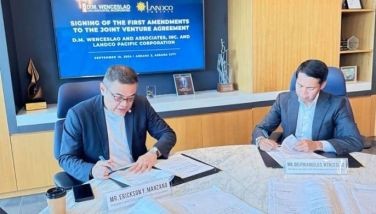A grandchild teaches me about bioremediation
August 29, 2006 | 12:00am
A granddaughter who is studying Marine Biology at Flinders University in South Australia – Bianca Marika Roces Pedrosa, has provided us with valuable information on what is called bioremediation which is an innovative environment-friendly method of dealing with the Guimaras oil spill. Below are excerpts of her letter.
"Just when our marine biodiversity has had time to regenerate, another oil spill plagues the country. Late last year, Napocor’s Power Barge 106 was carrying about 64,120 liters of fuel when it ran aground near Semirara Island in Caluya, Antique. Now, the M/T Solar 1 owned by Sunshine Maritime Development Corporation has sunk off the Guimaras Island last Friday, spilling liters of oil into the ocean.
"The oil spill cannot be contained as it continues to leak about 200,000 to 300,000 liters of fuel from the sunken tanker at a depth of 1,800 to 3,000 feet. The Philippine Coast Guard, along with other volunteers, does not have the resources to reach these depths and salvage the vessel. However, efforts are still being made by environmental advocates such as Greenpeace International, the ABS-CBN Foundation, non-government and government agencies, as well as the residents and fisher folk to clean up the sludge. They will use or will be using methods such as spraying of dispersants that will enhance the natural break-up of the hydrocarbons in the oil into smaller particles, spraying the shorelines with high-pressured hot water, as well as scooping up the sludge by hand. These methods may help in the removal of the oil but can be detrimental to some shoreline organisms as well.
"For this reason, Greenpeace has suggested the collection of human hair from salons, hairdressers and barbers that can help absorb the oil and make it easier for containment and later collection. Indigenous materials such as rice straw, cogon and tiger grass (walis tambo) could also be used as a substitute).
"Aside from the methods that have already been recommended, another innovative and environment-friendly method would be bioremediation. This involves the use of oleophilic marine bacteria (Acinetobacter calcoaceticus RAG-1) or Oil Eating Microbes (OEMs) that feed on aromatic, cyclic, branched and straight-chained hydrocarbons and break them down into non-toxic substances such as water, carbon and carbon dioxide. The bacteria can be dispersed throughout Guimaras Island to clean up the site. This method has been used and is proven in cleaning up the biggest oil spill in the world caused by the Exxon Valdez running aground in 1989. Bioremediation is a rapid and less expensive technique in cleaning up our valuable marine resources."
"Just when our marine biodiversity has had time to regenerate, another oil spill plagues the country. Late last year, Napocor’s Power Barge 106 was carrying about 64,120 liters of fuel when it ran aground near Semirara Island in Caluya, Antique. Now, the M/T Solar 1 owned by Sunshine Maritime Development Corporation has sunk off the Guimaras Island last Friday, spilling liters of oil into the ocean.
"The oil spill cannot be contained as it continues to leak about 200,000 to 300,000 liters of fuel from the sunken tanker at a depth of 1,800 to 3,000 feet. The Philippine Coast Guard, along with other volunteers, does not have the resources to reach these depths and salvage the vessel. However, efforts are still being made by environmental advocates such as Greenpeace International, the ABS-CBN Foundation, non-government and government agencies, as well as the residents and fisher folk to clean up the sludge. They will use or will be using methods such as spraying of dispersants that will enhance the natural break-up of the hydrocarbons in the oil into smaller particles, spraying the shorelines with high-pressured hot water, as well as scooping up the sludge by hand. These methods may help in the removal of the oil but can be detrimental to some shoreline organisms as well.
"For this reason, Greenpeace has suggested the collection of human hair from salons, hairdressers and barbers that can help absorb the oil and make it easier for containment and later collection. Indigenous materials such as rice straw, cogon and tiger grass (walis tambo) could also be used as a substitute).
"Aside from the methods that have already been recommended, another innovative and environment-friendly method would be bioremediation. This involves the use of oleophilic marine bacteria (Acinetobacter calcoaceticus RAG-1) or Oil Eating Microbes (OEMs) that feed on aromatic, cyclic, branched and straight-chained hydrocarbons and break them down into non-toxic substances such as water, carbon and carbon dioxide. The bacteria can be dispersed throughout Guimaras Island to clean up the site. This method has been used and is proven in cleaning up the biggest oil spill in the world caused by the Exxon Valdez running aground in 1989. Bioremediation is a rapid and less expensive technique in cleaning up our valuable marine resources."
BrandSpace Articles
<
>
- Latest
- Trending
Trending
Latest
Recommended

November 21, 2024 - 12:00am


























